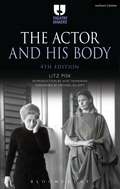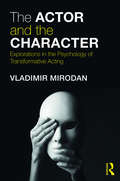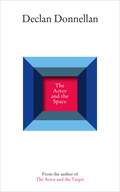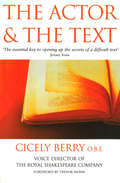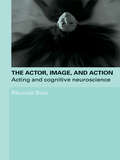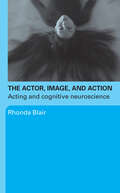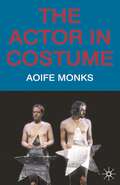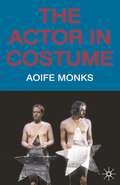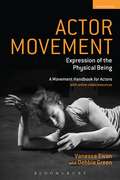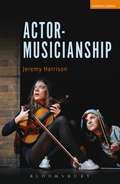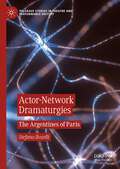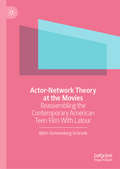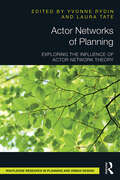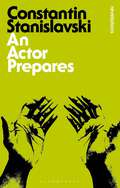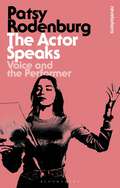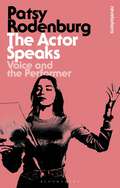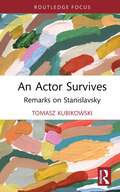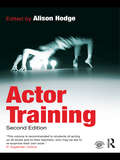- Table View
- List View
The Actor and His Body (Theatre Makers)
by Litz Pisk Ayse Tashkiran'Once you start working with someone like Litz you don't ever want to stop if you can help it' - Vanessa Redgrave Litz Pisk was widely regarded as the most influential teacher of modern theatre movement of the 20th Century. She innovated and advocated a physical training that sought to combine awareness, emotion and imagination specifically for the actor's craft. Her seminal book, The Actor and His Body, is the direct result of her unique dual career as a professional movement director and as an actor movement teacher working in leading British conservatoires. Pisk's quest was to find expression for the inner impulse that motivated actors to move. Her teachings, as outlined in this book, offer insight on the specific craft of the actor, and the relationship between movement, imagination and the 'need' to move. The Actor and His Body is also a practical manual for keeping the actor's body physically and expressively responsive. In addition, there are a range of movement exercises, illuminated by her exquisite line drawings, and a complete weekly programme which concentrates on movement practice within different timescales. This fourth edition features the original foreword by Michael Elliot as well as a new introduction by Ayse Tashkiran, contemporary movement director and Senior Lecturer at the Royal Central School of Speech and Drama, which contextualises Pisk's work.
The Actor and His Body (Theatre Makers)
by Litz Pisk Ayse Tashkiran'Once you start working with someone like Litz you don't ever want to stop if you can help it' - Vanessa Redgrave Litz Pisk was widely regarded as the most influential teacher of modern theatre movement of the 20th Century. She innovated and advocated a physical training that sought to combine awareness, emotion and imagination specifically for the actor's craft. Her seminal book, The Actor and His Body, is the direct result of her unique dual career as a professional movement director and as an actor movement teacher working in leading British conservatoires. Pisk's quest was to find expression for the inner impulse that motivated actors to move. Her teachings, as outlined in this book, offer insight on the specific craft of the actor, and the relationship between movement, imagination and the 'need' to move. The Actor and His Body is also a practical manual for keeping the actor's body physically and expressively responsive. In addition, there are a range of movement exercises, illuminated by her exquisite line drawings, and a complete weekly programme which concentrates on movement practice within different timescales. This fourth edition features the original foreword by Michael Elliot as well as a new introduction by Ayse Tashkiran, contemporary movement director and Senior Lecturer at the Royal Central School of Speech and Drama, which contextualises Pisk's work.
The Actor and the Character: Explorations in the Psychology of Transformative Acting
by Vladimir MirodanTransformative acting remains the aspiration of many an emerging actor, and constitutes the achievement of some of the most acclaimed performances of our age: Daniel Day-Lewis as Lincoln, Meryl Streep as Mrs Thatcher, Anthony Hopkins as Hannibal Lecter – the list is extensive, and we all have our favourites. But what are the physical and psychological processes which enable actors to create characters so different from themselves? To understand this unique phenomenon, Vladimir Mirodan provides both a historical overview of the evolution of notions of 'character' in Western theatre and a stunning contemporary analysis of the theoretical implications of transformative acting. The Actor and the Character: Surveys the main debates surrounding the concept of dramatic character and – contrary to recent trends – explains why transformative actors conceive their characters as ‘independent’ of their own personalities. Describes some important techniques used by actors to construct their characters by physical means: work on objects, neutral and character masks, Laban movement analysis, Viewpoints, etc. Examines the psychology behind transformative acting from the perspectives of both psychoanalysis and scientific psychology and, based on recent developments in psychology, asks whether transformation is not just acting folklore but may actually entail temporary changes to the brain structures of the actors. The Actor and the Character speaks not only to academics and students studying actor training and acting theory, but contributes to current lively academic debates around character. This is a compelling and original exploration of the limits of acting theory and practice, psychology, and creative work, in which Mirodan boldly re-examines some of the fundamental assumptions of actor training and some basic tenets of theatre practice to ask: What happens when one of us ‘becomes somebody else’?
The Actor and the Character: Explorations in the Psychology of Transformative Acting
by Vladimir MirodanTransformative acting remains the aspiration of many an emerging actor, and constitutes the achievement of some of the most acclaimed performances of our age: Daniel Day-Lewis as Lincoln, Meryl Streep as Mrs Thatcher, Anthony Hopkins as Hannibal Lecter – the list is extensive, and we all have our favourites. But what are the physical and psychological processes which enable actors to create characters so different from themselves? To understand this unique phenomenon, Vladimir Mirodan provides both a historical overview of the evolution of notions of 'character' in Western theatre and a stunning contemporary analysis of the theoretical implications of transformative acting. The Actor and the Character: Surveys the main debates surrounding the concept of dramatic character and – contrary to recent trends – explains why transformative actors conceive their characters as ‘independent’ of their own personalities. Describes some important techniques used by actors to construct their characters by physical means: work on objects, neutral and character masks, Laban movement analysis, Viewpoints, etc. Examines the psychology behind transformative acting from the perspectives of both psychoanalysis and scientific psychology and, based on recent developments in psychology, asks whether transformation is not just acting folklore but may actually entail temporary changes to the brain structures of the actors. The Actor and the Character speaks not only to academics and students studying actor training and acting theory, but contributes to current lively academic debates around character. This is a compelling and original exploration of the limits of acting theory and practice, psychology, and creative work, in which Mirodan boldly re-examines some of the fundamental assumptions of actor training and some basic tenets of theatre practice to ask: What happens when one of us ‘becomes somebody else’?
The Actor and the Space
by Declan DonnellanIn his bestselling book The Actor and the Target, Declan Donnellan laid out a fresh and radical approach to acting that has inspired actors around the world. Now, in The Actor and the Space, he develops and extends those ideas, exploring that most profound source of vitality in life as well as performance: the space around us. Tackling fundamental questions that face any actor – What makes performance better? How do I create a space for my character to live in? How do I tap into that space, and draw energy from it? – Donnellan offers a universal set of keys to unlock the mysteries of performance. Full of insightful precepts, acute psychology and practical, hands-on advice, the book presents a bold new way of thinking about acting, illustrated throughout with line-by-line analysis of scenes from Macbeth to show how it works in rehearsal and performance. Essential reading for any actor or theatre director, The Actor and the Space is also a fascinating distillation of the work of a world-leading director that will reward and enrich anyone with an interest in theatre. 'A hand grenade of a book. It contains all the humility and chutzpah you need to work in the theatre.' Cate Blanchett 'A wonderful book. Few directors think as deeply or perceptively about the art of acting as Declan Donnellan. This is an essential text for the actor, supremely useful, practical, elegant and profound.' Matthew Macfadyen 'Beautifully clear. This generous vision takes a very complex art form and makes it all seem so simple. The whole book is a key. Unlocking the problems actors face as they try to accept another reality long enough to let the audience get a glimpse of the best our art can offer – a glimpse into themselves.' Adrian Lester 'Declan Donnellan's profound insight and point of departure is that great theatre, like a child's sandcastle, inhabits a vulnerable and ever-changing space between the safe and the dangerous. There is a whole lot of wisdom in this book – about tragedy, human psychology, words, dread and about how great acting really works – conveyed with remarkable clarity and simplicity. It's worth sharing with non-actor friends for its insights into Macbeth alone. Most of all, it's a distillation of hard-won lessons learned from decades of immersion in the mysteries of theatre by one of the great directors of our day.' James Shapiro, Shakespeare scholar and author of 1599: A Year in the Life of William Shakespeare
The Actor And The Text
by Cicely BerryCicely Berry, Voice Director of the Royal Shakespeare Company, is world-famous for her voice teaching. The Actor and the Text is her classic book, distilled from years of working with actors of the highest calibre.
The Actor, Image, and Action: Acting and Cognitive Neuroscience
by Rhonda BlairThe Actor, Image and Action is a 'new generation' approach to the craft of acting; the first full-length study of actor training using the insights of cognitive neuroscience. In a brilliant reassessment of both the practice and theory of acting, Rhonda Blair examines the physiological relationship between bodily action and emotional experience. In doing so she provides the latest step in Stanislavsky's attempts to help the actor 'reach the unconscious by conscious means'. Recent developments in scientific thinking about the connections between biology and cognition require new ways of understanding many elements of human activity, including: imagination emotion memory physicality reason. The Actor, Image and Action looks at how these are in fact inseparable in the brain's structure and function, and their crucial importance to an actor’s engagement with a role. The book vastly improves our understanding of the actor's process and is a must for any actor or student of acting.
The Actor, Image, and Action: Acting and Cognitive Neuroscience
by Rhonda BlairThe Actor, Image and Action is a 'new generation' approach to the craft of acting; the first full-length study of actor training using the insights of cognitive neuroscience. In a brilliant reassessment of both the practice and theory of acting, Rhonda Blair examines the physiological relationship between bodily action and emotional experience. In doing so she provides the latest step in Stanislavsky's attempts to help the actor 'reach the unconscious by conscious means'. Recent developments in scientific thinking about the connections between biology and cognition require new ways of understanding many elements of human activity, including: imagination emotion memory physicality reason. The Actor, Image and Action looks at how these are in fact inseparable in the brain's structure and function, and their crucial importance to an actor’s engagement with a role. The book vastly improves our understanding of the actor's process and is a must for any actor or student of acting.
The Actor in Costume
by Aoife MonksHow do audiences look at actors in costume onstage? How does costume shape theatrical identity and form bodies? What do audiences wear to the theatre? This lively and cutting-edge book explores these questions, and engages with the various theoretical approaches to the study of actors in performance. Aoife Monks focuses in particular on the uncanny ways in which costume and the actor's body are indistinguishable in the audience's experience of a performance. From the role of costume in Modernist theatre to the actor's position in the fashion system, from nudity to stage ghosts, this wide-ranging exploration of costume, and its histories, argues for the centrality of costume to the spectator's experience at the theatre. Drawing on examples from paintings, photographs, live performances, novels, reviews, blogs and plays, Monks presents a vibrant analysis of the very peculiar work that actors and costumes do on the stage.
The Actor in Costume
by Aoife MonksHow do audiences look at actors in costume onstage? How does costume shape theatrical identity and form bodies? What do audiences wear to the theatre? This lively and cutting-edge book explores these questions, and engages with the various theoretical approaches to the study of actors in performance. Aoife Monks focuses in particular on the uncanny ways in which costume and the actor's body are indistinguishable in the audience's experience of a performance. From the role of costume in Modernist theatre to the actor's position in the fashion system, from nudity to stage ghosts, this wide-ranging exploration of costume, and its histories, argues for the centrality of costume to the spectator's experience at the theatre. Drawing on examples from paintings, photographs, live performances, novels, reviews, blogs and plays, Monks presents a vibrant analysis of the very peculiar work that actors and costumes do on the stage.
Actor Movement: Expression of the Physical Being (Performance Books)
by Vanessa Ewan Debbie GreenActor Movement: Expression of the Physical Being is a textbook and video resource for the working actor, the student and all those who lead and witness movement for the actor, including movement tutors, movement directors and directors. Great actors are not simply great interpreters of text; they are also great interpreters of movement; able to 'embody' all aspects of a character's life, with body and imagination as their instruments. In their work they are expected to become many bodies, all behaving differently from their own. Actors have to construct, inhabit and offer each character's body, with its multiplicity of known and unknown physical expression. Featuring: Over 155 exercises Four full actor movement processes for creating character Over 20 illustrations and images Complementary online footage supporting 26 of the practical elementsInspiring confidence in the actor to make fully owned physical choices and develop a love of movement, this essential new textbook is ideal for those actors seeking to give to their movement all the complexity and range possible for great acting.
Actor Movement: Expression of the Physical Being (Performance Books)
by Vanessa Ewan Debbie GreenActor Movement: Expression of the Physical Being is a textbook and video resource for the working actor, the student and all those who lead and witness movement for the actor, including movement tutors, movement directors and directors. Great actors are not simply great interpreters of text; they are also great interpreters of movement; able to 'embody' all aspects of a character's life, with body and imagination as their instruments. In their work they are expected to become many bodies, all behaving differently from their own. Actors have to construct, inhabit and offer each character's body, with its multiplicity of known and unknown physical expression. Featuring: Over 155 exercises Four full actor movement processes for creating character Over 20 illustrations and images Complementary online footage supporting 26 of the practical elementsInspiring confidence in the actor to make fully owned physical choices and develop a love of movement, this essential new textbook is ideal for those actors seeking to give to their movement all the complexity and range possible for great acting.
Actor-Musicianship (Performance Books)
by Jeremy HarrisonActor-musicianship is a permanent feature of the musical theatre landscape. Actor-musician shows can be seen from Bradford to Broadway, from village halls to international arena tours. However, with the exception of a couple of academic papers, there has been nothing written about this fascinating area of theatre practice. Jeremy Harrison's book addresses this deficit, operating as both a record of the development of the actor-musician movement and as a practical guide for students, educators, performers and practitioners. It explores the history of actor-musicianship, examining its origins, as well as investigating – and offering guidance on – how this specialist form of music theatre is created. It, in turn, acts as a means of defining an art form that has to date been left to lurk in the shadows of musical theatre; a subset with its own distinctive culture of performer, maker and audience, but as yet no formal recognition as a specialism in its own right. The actor-musician show is multifarious and as such this book targets those interested in mainstream commercial work, as well as alternative and avant-garde theatre practice. The book draws together expertise from a range of disciplines with contributions from many of the leading figures in this field, including performers, directors, teachers, MDs, producers and writers. It also features a foreword by theatre director John Doyle.
Actor-Musicianship (Performance Books)
by Jeremy HarrisonActor-musicianship is a permanent feature of the musical theatre landscape. Actor-musician shows can be seen from Bradford to Broadway, from village halls to international arena tours. However, with the exception of a couple of academic papers, there has been nothing written about this fascinating area of theatre practice. Jeremy Harrison's book addresses this deficit, operating as both a record of the development of the actor-musician movement and as a practical guide for students, educators, performers and practitioners. It explores the history of actor-musicianship, examining its origins, as well as investigating – and offering guidance on – how this specialist form of music theatre is created. It, in turn, acts as a means of defining an art form that has to date been left to lurk in the shadows of musical theatre; a subset with its own distinctive culture of performer, maker and audience, but as yet no formal recognition as a specialism in its own right. The actor-musician show is multifarious and as such this book targets those interested in mainstream commercial work, as well as alternative and avant-garde theatre practice. The book draws together expertise from a range of disciplines with contributions from many of the leading figures in this field, including performers, directors, teachers, MDs, producers and writers. It also features a foreword by theatre director John Doyle.
Actor-Network Dramaturgies: The Argentines of Paris (Palgrave Studies in Theatre and Performance History)
by Stefano BoselliThis book provides key critical tools to significantly broaden the readers’ perception of theatre and performance history: in line with posthuman thought, each chapter engages Actor-Network Theory and similar theories to reveal a comprehensive range of human and non-human agents whose collaborations impact theatre productions but are often overlooked. The volume also greatly expands the information available in English on the networks created by several Argentine artists. Through a transnational, transatlantic perspective, case studies refer to the lives, theatre companies, staged productions, and visual artworks of a number of artists who left Buenos Aires during the 1960s due to a mix of personal and political reasons. By establishing themselves in the French capital, queer playwright Copi and directors Jorge Lavelli, Alfredo Arias, and Jérôme Savary, among others, became part of the larger group of intellectuals known as “the Argentines of Paris” and dominated the Parisian theatre scene between the 1980s and 90s. Focusing on these Argentine artists and their nomadic peripeteias, the study thus offers a detailed description of the complexity of agencies and assemblages inextricably involved in theatre productions, including larger historical events, everyday objects, sexual orientation, microbes, and even those agents at work well before a production is conceived.
Actor-Network Theory at the Movies: Reassembling the Contemporary American Teen Film With Latour
by Björn Sonnenberg-SchrankThis book is one of the first to apply the theoretical tools proposed by French philosopher Bruno Latour to film studies. Through the example of the Hollywood Teen Film and with a particular focus on Actor-Network Theory (ANT), the book delineates how Teen Film has established itself as one of Hollywood’s most consistent and dynamic genres. While many productions may recycle formulaic patterns, there is also a proliferation of cinematic coming-of-age narratives that are aesthetically and politically progressive, experimental, and complex. The case studies develop a Latourian film semiotics as a flexible analytical approach which raises new questions, not only about the history, types and tropes of teen films, but also about their aesthetics, mediality, and composition. Through an exploration of a wide and diverse range of examples from the past decade, including films by female and African-American directors, urban and rural perspectives, and non-heteronormative sexualities, Actor-Network Theory at the Movies demonstrates how the classic Teen Film canon has been regurgitated, expanded, and renewed.
Actor Networks of Planning: Exploring the Influence of Actor Network Theory
by Yvonne Rydin Laura TatePlanning is centrally focused on places which are significant to people, including both the built and natural environments. In making changes to these places, planning outcomes inevitably benefit some and disadvantage others. It is perhaps surprising that Actor Network Theory (ANT) has only recently been considered as an appropriate lens through which to understand planning practice. This book brings together an international range of contributors to explore such potential of ANT in more detail. While it can be thought of as a subset of complexity theory, given its appreciation for non-linear processes and responses, ANT has its roots in the sociology of scientific and technology studies. ANT now comprises a rich set of concepts that can be applied in research, theoretical and empirical. It is a relational approach that posits a radical symmetry between social and material actors (or actants). It suggests the importance of dynamic processes by which networks of relationships become formed, shift and have effect. And while not inherently normative, ANT has the potential to strengthen other more normative domains of planning theory through its unique analytical lens. However, this requires theoretical and empirical work and the papers in this volume undertake such work. This is the first volume to provide a full consideration of how ANT can contribute to planning studies, and suggests a research agenda for conceptual development and empirical application of the theory.
Actor Networks of Planning: Exploring the Influence of Actor Network Theory
by Yvonne Rydin Laura TatePlanning is centrally focused on places which are significant to people, including both the built and natural environments. In making changes to these places, planning outcomes inevitably benefit some and disadvantage others. It is perhaps surprising that Actor Network Theory (ANT) has only recently been considered as an appropriate lens through which to understand planning practice. This book brings together an international range of contributors to explore such potential of ANT in more detail. While it can be thought of as a subset of complexity theory, given its appreciation for non-linear processes and responses, ANT has its roots in the sociology of scientific and technology studies. ANT now comprises a rich set of concepts that can be applied in research, theoretical and empirical. It is a relational approach that posits a radical symmetry between social and material actors (or actants). It suggests the importance of dynamic processes by which networks of relationships become formed, shift and have effect. And while not inherently normative, ANT has the potential to strengthen other more normative domains of planning theory through its unique analytical lens. However, this requires theoretical and empirical work and the papers in this volume undertake such work. This is the first volume to provide a full consideration of how ANT can contribute to planning studies, and suggests a research agenda for conceptual development and empirical application of the theory.
An Actor Prepares (Bloomsbury Revelations)
by Constantin StanislavskiAn Actor Prepares is the most famous acting training book ever to have been written and the work of Stanislavski has inspired generations of actors and trainers. This translation was the first to introduce Stanislavski's 'system' to the English speaking world and has stood the test of time in acting classes to this day. Stanislavski here deals with the inward preparation an actor must undergo in order to explore a role to the full. He introduces the concepts of the 'magic of' units and objectives, of emotion memory, of the super-objective and many more now famous rehearsal aids. An inspirational book presented in a drama class structure to ignite powerful performances.
The Actor Speaks: Voice and the Performer (Bloomsbury Revelations)
by Patsy RodenburgFrom the bestselling author of The Right to Speak and The Need for Words comes this Bloomsbury Revelations edition of the essential guide to voice work: The Actor Speaks. Beginning with what every first-year acting student faces in class and ending with what leading professional actors must achieve every night on stage, Patsy Rodenburg's celebrated work as one of the world's foremost voice and acting coaches is fully revealed in this thoughtful and inspirational book about acting.Written for the training and working actor, Rodenburg's book brings to life a wide range of exercises and methods to release the actor's voice, covering everything from posture, breath and the body, performing in specific spaces, previews and first performances, managing different length runs, using microphones and dealing with an ageing or sick voice. This book allows the reader to perform every night, reaching the pitch, passion and vocal intensity that the best roles require.
The Actor Speaks: Voice and the Performer (Bloomsbury Revelations)
by Patsy RodenburgFrom the bestselling author of The Right to Speak and The Need for Words comes this Bloomsbury Revelations edition of the essential guide to voice work: The Actor Speaks. Beginning with what every first-year acting student faces in class and ending with what leading professional actors must achieve every night on stage, Patsy Rodenburg's celebrated work as one of the world's foremost voice and acting coaches is fully revealed in this thoughtful and inspirational book about acting.Written for the training and working actor, Rodenburg's book brings to life a wide range of exercises and methods to release the actor's voice, covering everything from posture, breath and the body, performing in specific spaces, previews and first performances, managing different length runs, using microphones and dealing with an ageing or sick voice. This book allows the reader to perform every night, reaching the pitch, passion and vocal intensity that the best roles require.
An Actor Survives: Remarks on Stanislavsky (Routledge Advances in Theatre & Performance Studies)
by Tomasz KubikowskiThis book focuses on the analysis and interpretation of the first volume of the book An Actor’s Work by Konstantin Stanislavsky. This volume is the only part of his planned major work on theatre art that he was able to finish and authorise before his death. Its highly edited variant has long been known as ‘An Actor Prepares’ in the English-speaking world. Tomasz Kubikowski explores Stanislavsky’s material not only as a handbook of acting but also as a philosophical testament of Stanislavsky, in which he attempts to contain his most essential experiences and reflections. This book explores the underlying theme of ‘survival’ in its various meanings, from professional to existential; and the mechanisms and actions we attempt to survive. This study will be of great interest to students and scholars in theatre and performance studies.
An Actor Survives: Remarks on Stanislavsky (Routledge Advances in Theatre & Performance Studies)
by Tomasz KubikowskiThis book focuses on the analysis and interpretation of the first volume of the book An Actor’s Work by Konstantin Stanislavsky. This volume is the only part of his planned major work on theatre art that he was able to finish and authorise before his death. Its highly edited variant has long been known as ‘An Actor Prepares’ in the English-speaking world. Tomasz Kubikowski explores Stanislavsky’s material not only as a handbook of acting but also as a philosophical testament of Stanislavsky, in which he attempts to contain his most essential experiences and reflections. This book explores the underlying theme of ‘survival’ in its various meanings, from professional to existential; and the mechanisms and actions we attempt to survive. This study will be of great interest to students and scholars in theatre and performance studies.
Actor Training
by Alison HodgeActor Training expands on Alison Hodge’s highly-acclaimed and best-selling Twentieth Century Actor Training. This exciting second edition radically updates the original book making it even more valuable for any student of the history and practice of actor training. The bibliography is brought right up to date and many chapters are revised. In addition, eight more practitioners are included - and forty more photographs - to create a stunningly comprehensive study. The practitioners included are: Stella Adler; Eugenio Barba; Augusto Boal; Anne Bogart; Bertolt Brecht; Peter Brook; Michael Chekhov; Joseph Chaikin; Jacques Copeau; Philippe Gaulier; Jerzy Grotowski; Maria Knebel; Jacques Lecoq; Joan Littlewood; Sanford Meisner; Vsevolod Meyerhold; Ariane Mnouchkine; Monika Pagneux; Michel Saint-Denis; W?odzimierz Staniewski; Konstantin Stanislavsky; Lee Strasberg The historical, cultural and political context of each practitioner’s work is clearly set out by leading experts and accompanied by an incisive and enlightening analysis of the main principles of their training, practical exercises and key productions. This book is an invaluable introduction to the principles and practice of actor training and its role in shaping modern theatre.
Actor Training
by Alison HodgeActor Training expands on Alison Hodge’s highly-acclaimed and best-selling Twentieth Century Actor Training. This exciting second edition radically updates the original book making it even more valuable for any student of the history and practice of actor training. The bibliography is brought right up to date and many chapters are revised. In addition, eight more practitioners are included - and forty more photographs - to create a stunningly comprehensive study. The practitioners included are: Stella Adler; Eugenio Barba; Augusto Boal; Anne Bogart; Bertolt Brecht; Peter Brook; Michael Chekhov; Joseph Chaikin; Jacques Copeau; Philippe Gaulier; Jerzy Grotowski; Maria Knebel; Jacques Lecoq; Joan Littlewood; Sanford Meisner; Vsevolod Meyerhold; Ariane Mnouchkine; Monika Pagneux; Michel Saint-Denis; W?odzimierz Staniewski; Konstantin Stanislavsky; Lee Strasberg The historical, cultural and political context of each practitioner’s work is clearly set out by leading experts and accompanied by an incisive and enlightening analysis of the main principles of their training, practical exercises and key productions. This book is an invaluable introduction to the principles and practice of actor training and its role in shaping modern theatre.
